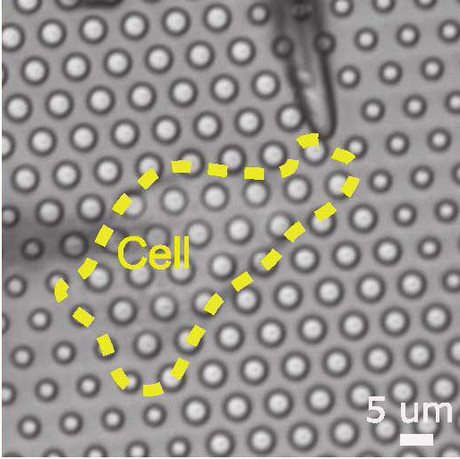Nanomanipulator enables UNSW researchers to probe the inner workings of cells

The mechanism of how cells work is key to understanding how tumours metastasize as well as tissue regeneration and other bodily functions. The process of mechanotransduction, or how a cell converts a physical stimuli into an electrical response, is fundamental to these understandings.
Dr Kate Poole, Group Leader — Cellular Mechanotransduction, University of New South Wales and her team are carrying out cutting-edge research into the molecules that are produced following exposure to a mechanical stimulus and how they interpret these molecules. Her team also works with the EMBL (European Molecular Biology Laboratory) Australia node for Single Molecule Science.
One of the challenging parts of Poole’s research is to be able to ‘poke’ cells in a precise and repeatable fashion at the cellular level that replicates physiological conditions. To achieve this, she grows cells on a pillar array, akin to a microscopic bed of nails. She can then poke the cells using individual pillars using a piezo-controlled nanomanipulator that is gentle enough to apply a specific load without rupturing the cell membrane. Her focus is on two main areas: how cells in cartilage respond to mechanical stimuli, which has relevance to osteoarthritis, a degenerative condition that affects 1 in 11 Australians or over 2.1 million people; and how cells that migrate through the body sense the mechanics of their surroundings, which will provide insights into how cancer cells divide and spread.
Poole’s current research at UNSW takes her postdoctoral work at the Max Delbrück Center for Molecular Medicine in Berlin to the next level. Poole’s lab in Berlin used a Kleindiek MM3A-LM nanomanipulator and she said “the set-up worked incredibly well” and “there was no way that I was going to use anything that wasn’t the Kleindiek”. So, her lab in Australia is now equipped with two of the same nanomanipulators.
AXT distributes Kleindiek products, including the range of nanomanipulators, in Australia and New Zealand.
A non-destructive way to locate microplastics in body tissue
Currently available analytical methods either destroy tissue in the body or do not allow...
Rapid imaging method shows how medicine moves beneath the skin
Researchers have developed a rapid imaging technique that allows them to visualise, within...
Fluorescent molecules glow in water, enhancing cell imaging
Researchers have developed a new family of fluorescent molecules that glow in a surprising way,...





